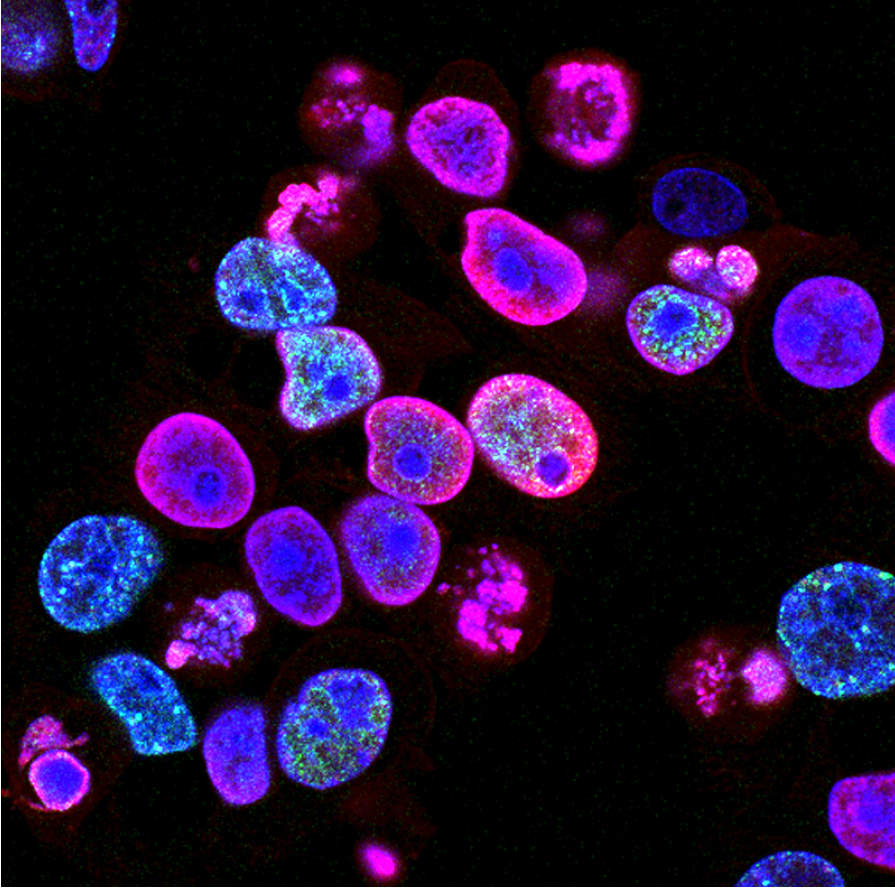CRISPR Reagents: Cas9 Nucleases, gRNA Control Kits, CRISPR Transfection Reagents, and more
EditCo's highly efficient CRISPR kits simplify your science. Complete your CRISPR experiment with SpCas9 nuclease, transfection optimization kits, and add-on controls.
Easily Build Your CRISPR Kit
-
Add on to Your gRNA Knockout Kit: Customize your CRISPR kits for a ready-to-use solution.
-
Order Standalone Reagents: Individually order SpCas9 protein, transfection reagents, control kits and more.
-
Streamlined Online Ordering: Simplify shopping through our online portal.

All the components for your CRISPR experiments, ready to go.
Along with EditCo's high-efficiency XDel Gene Knockout Kits and Arrayed gRNA Libraries, we offer essential experimental components such as CRISPR Cas9 nuclease kits and gRNA control kits to support successful genome editing. CRISPR transfection reagents, like EditCo's transfection optimization kit, allow you to bypass the hard and slow process of optimization on your own.
These controls can be purchased as kits, individually along with SpCas9 protein through our add-on reagents ordering page or can be added in your Arrayed sgRNA Library.
CRISPR Controls
CRISPR controls are an essential component of gene-editing experiment workflows, ensuring accuracy, efficiency, and reproducibility. When building an assay, these controls help optimize workflows across different cell lines and establish a baseline for comparison. During the screening process, they distinguish gene-editing effects from experimental artifacts and assess editing efficiency. Finally, CRISPR controls play a crucial role in optimizing, validating results and troubleshooting when needed. Evaluating whether and how well genome editing worked is just as critical as the outcome itself.
Positive controls
CRISPR positive controls are necessary to validate and monitor the efficiency of the CRISPR reagents being used in any gene editing experiment. These positive controls are validated sgRNA sequences that have demonstrated high editing efficiency across different cell types and are available in both XDel design and single-guide format.
These controls are ideal for building and optimizing your assay, optimizing your experimental conditions, monitoring the gene editing efficiency across different cell lines or workflows, and troubleshooting. They can be used in any cell type, including immortalized, iPSC, and primary cells.

* Each cell line was genetically modified using EditCo’s proprietary process under optimized editing conditions. Editing efficiency was evaluated 72 hours post-nucleofection. The targeted genomic region was amplified via PCR, sequenced using Sanger sequencing, and analyzed with the ICE analysis tool to determine knockout (KO) levels. To assess the impact of CRISPR editing on cell growth, total cell numbers were measured using a fluorescence-based cell counting assay 72 hours post-nucleofection. Hoechst staining was used to label all cells, while dead cells were identified via propidium iodide staining. The number of live cells was determined by subtracting dead cells from the total count.
** Data from a representative control is highlighted below.
![]()
![]()

Figure 1. Positive controls provide high editing efficiency without affecting cell viability. A) Knockout score and B) Cell viability for representative positive control, IFNGR, versus negative control, NTC3.
Negative controls
A negative control in a CRISPR-Cas9 experiment is used to ensure that observed effects are due to the intended genetic perturbation rather than artifacts from the experimental workflow (such as off-target effects, cell stress, or other non-specific influences). These non-targeting gRNA sequences are designed to not target any genomic location in the human & mouse species and therefore no editing event occurs with SpCas9. These controls are validated sequences that have been shown to have no effect on cell viability across different cell types and are available in a single-guide format.
These controls are essential in gene-editing experiments to compare the phenotype of cells treated with a gene-targeting guide RNA to those treated with a non-targeting guide RNA. They are commonly included in CRISPR screens to help identify potential false positives.

** Data from a representative control is highlighted below.

Figure 2. Negative Controls do not affect cell editing or cell viability. A) Knockout score and B) Cell viability for representative negative control, NTC3 versus SpCas9 only.
AAVS1 controls
AAVS1 is a safe harbor site in the human genome, located in intron 1 of the PPP1R2C gene. AAVS1 is a well-validated “safe harbor” often used as negative controls to ensure that observed phenotypes are due to the intended gene editing and not off-target effects or other non-specific events. Additionally, AAVS1 can serve as positive controls to validate gene editing efficiency. Editing in this site is known not to cause any adverse effects on cells. The available sgRNAs targeting this site have high editing efficiency across different cell types and include both XDel design and single-guide format.
These controls are essential for evaluating the baseline cellular response to SpCas9 cutting in the absence of a phenotypic readout. They serve as negative controls, helping to distinguish intended gene-editing effects from unintended functional changes in cells. AAVS1 controls, in particular, are widely used in CRISPR screening experiments, where phenotypic readouts are typically assessed. These can be used in any cell type including immortalized, iPSC and primary cells.

* Each cell line was genetically modified using EditCo’s proprietary process under optimized editing conditions. Editing efficiency was evaluated 72 hours post-nucleofection. The targeted genomic region was amplified via PCR, sequenced using Sanger sequencing, and analyzed with the ICE analysis tool to determine knockout (KO) levels. To assess the impact of CRISPR editing on cell growth, total cell numbers were measured using a fluorescence-based cell counting assay 72 hours post-nucleofection. Hoechst staining was used to label all cells, while dead cells were identified via propidium iodide staining. The number of live cells was determined by subtracting dead cells from the total count.
** Data from a representative control is highlighted below.

Figure 3. AAVS1 controls provide high editing efficiency of safe harbor site AAVS1 without affecting cell viability. A) Knockout score and B) Cell viability for representative AAVS1 control, AAVS1 #4, versus negative control, NTC3.
Lethal controls
Lethal controls are positive controls that cause a cell death phenotype. These controls generally will target essential genes that are required for cell growth, therefore, when the gene is knocked out, the cells do not survive. This control is validated sequences that have demonstrated high editing efficiency and hinders cell growth across different cell types and are provided in the XDel format. PLK1 knockout cells undergo cell death within 3 days of transfection and can be easily detected using common dead cell dyes, such as propidium iodide.
This control is ideal for optimizing the experimental conditions of your gene editing experiment and validating the transfection efficiency since they provide a very clear phenotype easily assessed via microscopy or a simple cell viability assay.

** Data from a representative control is highlighted below.

Figure 4. Lethal control PLK1 provides high editing efficiency of cell cycle regulator gene PLK1 and induces cell death within 3 days. A) Knockout score and B) Cell viability for lethal control, PLK1, versus negative control, NTC3.
Controls & Transfection Optimization Kits
These kits include positive controls, available in either XDel or single-guide format, that are useful for optimizing transfection conditions or gaining familiarity with CRISPR/Cas9 technology before targeting your gene of interest. Each kit contains everything needed for a complete CRISPR experiment, including controls, SpCas9 protein, and primers.
The Transfection Optimization Kit (TOK) is designed to be used alongside the Gene Knockout Kit, as both leverage the XDel strategy for efficient gene editing.

* Each cell line was genetically modified using EditCo’s proprietary process under optimized editing conditions. Editing efficiency was evaluated 72 hours post-nucleofection. The targeted genomic region was amplified via PCR, sequenced using Sanger sequencing, and analyzed with the ICE analysis tool to determine knockout (KO) levels. To assess the impact of CRISPR editing on cell growth, total cell numbers were measured using a fluorescence-based cell counting assay 72 hours post-nucleofection. Hoechst staining was used to label all cells, while dead cells were identified via propidium iodide staining. The number of live cells was determined by subtracting dead cells from the total count.
SpCas9 Protein
EditCo offers high-quality Streptococcus pyogenes Cas9 protein with two nuclear localization signals (2NLS) for enhanced nuclear delivery. This SpCas9 protein has been validated and demonstrates high editing efficiency across various loci in both in vitro and ex vivo experiments. Cas9 in protein form is ideal for RNP-based CRISPR experiments, enabling rapid and transient genome editing with minimal off-target effects. Delivered directly as a ribonucleoprotein (RNP) complex with guide RNA, it eliminates the need for cellular transcription or translation, providing fast action and greater control over editing outcomes. The protein is also compatible with multiple transfection methods, including electroporation and lipofection.

* HEK293T cells were genetically edited using EditCo’s proprietary process under optimized conditions to target an endogenous genomic site. Editing efficiency was assessed 72 hours post-nucleofection. The targeted genomic region was amplified via polymerase chain reaction (PCR), sequenced using Sanger sequencing, and analyzed with the ICE (Inference of CRISPR Edits) tool to quantify knockout (KO) levels.
Tris-EDTA Buffer
We offer Tris-EDTA Buffer and Nuclease-free Water that can be used to resuspend or dilute your gRNA libraries.

These controls can be purchased as kits, individually along with SpCas9 protein through our add-ons page or can be added in your custom arrayed library.
Resources
Integrating our core CRISPR expertise, high-quality reagents, and automated processes, we deliver the best edited cell-based models at any scale.
.webp?width=2000&height=1500&name=updated_workcell%20(1).webp)
Use cases diam faucibus donec pretium leo risus commodo sit. Phasellus a sit.



Quisque amet eu viverra aliquam sed. Montes nulla nisi sit vel urna leo. Nisi donec consectetur bibendum tortor. Gravida arcu lorem venenatis nulla sodales quis sed.
Testimonials consectitur amet sed
Congue fermentum eros leo commodo. Integer vitae vitae ac amet. Vitae sed lectus vel lacus adipiscing nulla facilisis mauris porttitor. Viverra elementum odio vitae id.

Viverra aliquam volutpat interdum quisque vel mattis. Malesuada aliquam egestas pharetra a tempus ullamcorper egestas.

Nibh luctus pulvinar sagittis faucibus commodo vitae purus. Ullamcorper dictum.

Congue fermentum eros leo commodo. Integer vitae vitae ac amet. Vitae sed lectus vel lacus adipiscing nulla facilisis mauris porttitor. Viverra elementum odio vitae id.

Congue fermentum eros leo commodo. Integer vitae vitae ac amet. Vitae sed lectus vel lacus adipiscing nulla facilisis mauris porttitor. Viverra elementum odio vitae id.

Congue fermentum eros leo commodo. Integer vitae vitae ac amet. Vitae sed lectus vel lacus adipiscing nulla facilisis mauris porttitor. Viverra elementum odio vitae id.

Lectus Pluristyx eu vel leo lectus mi. Viverra cursus neque eget proin.
Pellentesque nec tempus ultrices purus amet adipiscing aliquam. Posuere imperdiet adipiscing non blandit non. Sed eros vel sodales magna sem tincidunt orci risus. Molestie hendrerit cursus faucibus ac neque eget turpis. Arcu leo risus iaculis mi. Tortor bibendum sed cras pretium leo.
0+
0+
0+
Lorem Ipsum Dolor Heading
Etiam sollicitudin, ipsum eu pulvinar rutrum, tellus ipsum laoreet sapien, quis venenatis ante odio sit amet eros. Duis arcu tortor, suscipit eget, imperdiet nec, imperdiet iaculis, ipsum. Maecenas nec odio et ante tincidunt tempus. Donec elit libero, sodales nec, volutpat a, suscipit non, turpis. Quisque id mi.
Resources aliquam procte





